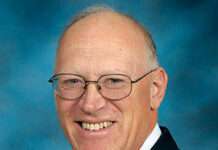K-State nutrition expert says guidelines account for busy lives
MANHATTAN, Kan. – In the United States, it is estimated that $117 billion in annual health care costs and about 10% of premature mortality are associated with too little physical activity.
Sandy Procter has a solution: Get up and move.
“It’s one of the most important things we can do to invest in our own personal health, and in the health of those who we love to encourage physical activity, to make room for it in our lives, and to build it in so that it becomes as automatic and repeated as it possibly can,” said Procter, a nutrition and health specialist at Kansas State University.
The U.S. Department of Health and Human Services published the Physical Activity Guidelines for Americans in 2018 to encourage health from a very young age. In fact, for the first time, the guidelines even include physical activity recommendations for pre-school aged children.
In summary, the guidelines include:
• Preschool-aged children (ages 3-5 years) should be physically active throughout the day, including play that includes many activity types.
• Children and adolescents should do 60 minutes or more of moderate to vigorous physical activity, including aerobic, muscle-strengthening and bone-strengthening exercises.
• Adults should do at least 150-300 minutes a week of moderate intensity, or 75-150 minutes of vigorous aerobic activity, plus muscle-strengthening activities of moderate to vigorous intensity.
• The guidelines for older adults are similar to adults, but also include balance training, and seeking exercises that accommodate health conditions, if necessary.
The guidelines include additional recommendations for women during pregnancy and the postpartum period; and adults with chronic health conditions or disabilities.
The government’s guidelines are “like a prescription, really,” according to Procter.
“Research studies have upheld the idea that adults need at least 150 minutes of moderate aerobic activity, meaning we’re moving and taking in oxygen that gets our heart beating faster. That comes out to 30 minutes a day for at least five days a week.”
At one time, Procter added, the physical activity guidelines indicated that activity could be done in chunks of time during the day, but should be sustained for at least 10 minutes.
“They’ve even stepped back from that and said it’s like a bank account,” she said. “Any deposit you make for the good is going to be there and be good for you. It doesn’t have to be 10 minutes at a time.”
She suggested looking for opportunities during the day to fit in a quick workout: during TV commercial breaks or between Zoom calls, for example.
“You can really add to your total every day and meet those minimums in a way that doesn’t necessarily support the idea that you don’t have time to exercise.”
“One of the best things we can do to keep ourselves physically active is to just get started and realize that it can be – and is – really enjoyable and it can also be habit-forming in a good way. You know, you’ll just feel better after a while and you start looking forward to that 15 minute jaunt with the dog between meetings.”
Along with physical activity, Procter encourages healthy eating (including fruits and vegetables), drinking water and adequate sleep as important keys to good health.
More information on healthy living is available online from K-State’s Department of Food, Nutrition, Dietetics and Health.
FOR PRINT PUBLICATIONS: Links used in this story
Physical Activity Guidelines for Americans, https://health.gov/sites/default/files/2019-09/Physical_Activity_Guidelines_2nd_edition.pdf
K-State’s Department of Food, Nutrition, Dietetics and Health, www.hhs.k-state.edu/fndh
K State Research and Extension is a short name for the Kansas State University Agricultural Experiment Station and Cooperative Extension Service, a program designed to generate and distribute useful knowledge for the well being of Kansans. Supported by county, state, federal and private funds, the program has county extension offices, experiment fields, area extension offices and regional research centers statewide. Its headquarters is on the K State campus in Manhattan. For more information, visit www.ksre.ksu.edu. K-State Research and Extension is an equal opportunity provider and employer.
Story by:
Pat Melgares
785-532-1160
[email protected]
For more information:
Sandy Procter
785-532-1675
[email protected]





